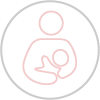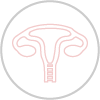Your pelvic organs are your bladder, womb (uterus) and rectum. Pelvic organ support primarily comes from the pelvic floor muscles and sphincters beneath these organs, and the connective tissue and thickened fascia (that serve as ligaments) above and around these organs. During pregnancy and following childbirth, when the pelvic floor muscles are stretched, torn / damaged, and subsequently weakened – the fascia and ligaments have to bear the brunt of the weight of the organs. Immediately, or eventually they may fail, allowing the pelvic organs to descend, or drop down, from their usual position and press into the vaginal wall.
It is usual to experience pelvic floor weakness, feelings of heaviness down below, or even feel a small bulge immediately following delivery of your baby, that may last for a few weeks. This is normal and may resolve with time and can just be attributed to post-birth laxity of the tissues. For some women, these feelings never go away, can worsen and can be accompanied with other symptoms. Symptoms such as urinary or faecal incontinence/frequency/hesitation or constipation, difficulty and pain on intercourse or using tampons, discomfort sitting or walking and difficulty exercising.
There are 3 types of pelvic organ prolapse:
- Cystocele and urethrocele: A cystocele occurs when the bladder drops back and protrudes into the front wall of the vagina. A similar defect known as a urethrocele, develops when the urethra presses into the front vaginal wall.
- Rectocele: Part of the rectum bulges into the back wall of the vagina, sometimes causing difficulty with bowel motions.
- Uterine prolapse: The uterus descends and drops down into the vaginal passage.
Women who have had multiple vaginal births are at greater risk of pelvic organ prolapse, particularly later in life after menopause even if they don’t have any initial symptoms following childbirth.
Symptoms of Prolapse:
- Pressure and pain, a feeling of ‘heaviness’, ‘bearing down’ or a ‘bulge’
- Low back pain, pelvic pain, low abdominal pain – like a deep constant ‘period pain’
- Urinary symptoms – a cystocele, urethrocele and uterine prolapse can cause stress urinary incontinence (SUI), difficulty in starting to urinate, increased frequency
- Bowel symptoms – a rectocele may cause problems passing stools, the prolapse forms a pocket just above the anal sphincter, causing stools to be trapped, an increase in pain, pressure and constipation
- Sexual problems – pain and discomfort, psychological stress
- Difficulties using or holding in tampons
- Discomfort underneath when sitting on harder chairs
If you have pain and discomfort from pelvic organ prolapse, there are lots of non-invasive, nonsurgical approaches that are well evidenced in improving symptoms.
Physiotherapy for Pelvic Organ Prolapse:
- In depth assessment of your gynaecological and obstetric history
- Internal examination (with your consent) to assess position of organs, quality of tissues, tone, activity and strength of the pelvic floor muscles.
- Discussion of treatment options
- Activity modification, lifestyle management
- Teach correct and effective pelvic floor muscle exercises, technique, quality and type
- Teach abdominal strength and stability exercises
- Use of equipment, muscle stimulation, biofeedback as indicated



